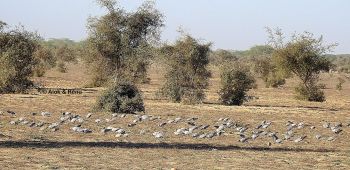(→External Links: New combined GSearch) |
|||
| (17 intermediate revisions by 7 users not shown) | |||
| Line 1: | Line 1: | ||
| − | {{ | + | [[Image:YEPigeonVR.jpg|thumb|550px|right|Photo © by {{user|Vipul+Ramanuj|Vipul Ramanuj}}<br /> Rajasthan, [[India]], January 2016]] |
| + | '''Alternative name: Pale-backed Pigeon''' | ||
;[[:Category:Columba|Columba]] eversmanni | ;[[:Category:Columba|Columba]] eversmanni | ||
| + | [[Image:Yellow_Eyed_Pigeon_alok_2.JPG|thumb|350px|right|Photo © by {{user|aloktewari|Alok Tewari}}<br />Jorbeer Conservation Reserve, Bikaner, Rajasthan, [[India]], 21 February 2022]] | ||
==Identification== | ==Identification== | ||
| − | + | [[Image:Yellow_Eyed_Pigeon_alok_3.JPG|thumb|350px|right|Photo © by {{user|aloktewari|Alok Tewari}}<br />Part of a large foraging flock, feeding on grass seeds, little after day-break.<br />Jorbeer Conservation Reserve, Bikaner, Rajasthan, [[India]], 22 February 2022]] | |
| + | 25–31 cm (9¾-12 in) | ||
| + | *Mainly bluish-grey overall plumage | ||
| + | *Pinkish crown and breast | ||
| + | *Whitish underwing-[[Topography#General Anatomy|coverts]], lower back and upper rump | ||
| + | *Yellow eyes and eye-ring | ||
==Distribution== | ==Distribution== | ||
| − | + | [[Middle East]] and [[Asia]]: found from north-eastern [[Iran]] to [[Siberia]], north-western [[India]] and extreme western [[China]]. | |
| + | ==Taxonomy== | ||
| + | This is a [[Dictionary_M-O#M|monotypic]] species<sup>[[#References|[1]]]</sup>. | ||
| − | |||
==Habitat== | ==Habitat== | ||
| − | Open, sparsely wooded habitats in the mountains | + | Steppe and nearby lowlands, deserts. Open, semi arid, sparsely wooded habitats in the mountains. |
==Behaviour== | ==Behaviour== | ||
Usually found in flocks. | Usually found in flocks. | ||
| − | + | ====Diet==== | |
| − | + | They forage on the ground for seeds, grain and other cereals. | |
| + | ====Breeding==== | ||
| + | They nest in cracks in cliffs and in roller burrows. | ||
| + | ==References== | ||
| + | #{{Ref-Clements6thAug19}}#birdbase.hokkaido | ||
| + | #BirdLife International | ||
| + | #Handbook of the Birds of the World Alive (retrieved Jan 2018) | ||
| + | #Wikipedia | ||
| + | {{ref}} | ||
==External Links== | ==External Links== | ||
| − | {{GSearch|Columba | + | {{GSearch|"Columba eversmanni"{{!}} "Yellow-eyed Pigeon" {{!}} "Pale-backed Pigeon"}} |
| − | + | <br /> | |
| + | {{VSearch|"Columba eversmanni"{{!}} "Yellow-eyed Pigeon" {{!}} "Pale-backed Pigeon"}} | ||
| + | {{GS-checked}}1 | ||
| + | <br /> | ||
| + | <br /> | ||
| − | [[Category:Birds]] [[Category: | + | [[Category:Birds]][[Category:Columba]][[Category:Videos]] |
Latest revision as of 20:05, 26 April 2023
Alternative name: Pale-backed Pigeon
- Columba eversmanni
Identification

Photo © by Alok Tewari
Part of a large foraging flock, feeding on grass seeds, little after day-break.
Jorbeer Conservation Reserve, Bikaner, Rajasthan, India, 22 February 2022
Part of a large foraging flock, feeding on grass seeds, little after day-break.
Jorbeer Conservation Reserve, Bikaner, Rajasthan, India, 22 February 2022
25–31 cm (9¾-12 in)
- Mainly bluish-grey overall plumage
- Pinkish crown and breast
- Whitish underwing-coverts, lower back and upper rump
- Yellow eyes and eye-ring
Distribution
Middle East and Asia: found from north-eastern Iran to Siberia, north-western India and extreme western China.
Taxonomy
This is a monotypic species[1].
Habitat
Steppe and nearby lowlands, deserts. Open, semi arid, sparsely wooded habitats in the mountains.
Behaviour
Usually found in flocks.
Diet
They forage on the ground for seeds, grain and other cereals.
Breeding
They nest in cracks in cliffs and in roller burrows.
References
- Clements, J. F., T. S. Schulenberg, M. J. Iliff, S. M. Billerman, T. A. Fredericks, B. L. Sullivan, and C. L. Wood. 2019. The eBird/Clements Checklist of Birds of the World: v2019. Downloaded from http://www.birds.cornell.edu/clementschecklist/download/
- birdbase.hokkaido
- BirdLife International
- Handbook of the Birds of the World Alive (retrieved Jan 2018)
- Wikipedia
Recommended Citation
- BirdForum Opus contributors. (2024) Yellow-eyed Pigeon. In: BirdForum, the forum for wild birds and birding. Retrieved 16 June 2024 from https://www.birdforum.net/opus/Yellow-eyed_Pigeon
External Links
GSearch checked for 2020 platform.1





